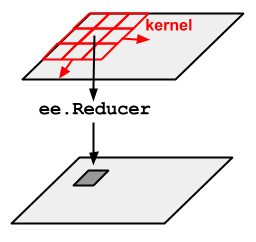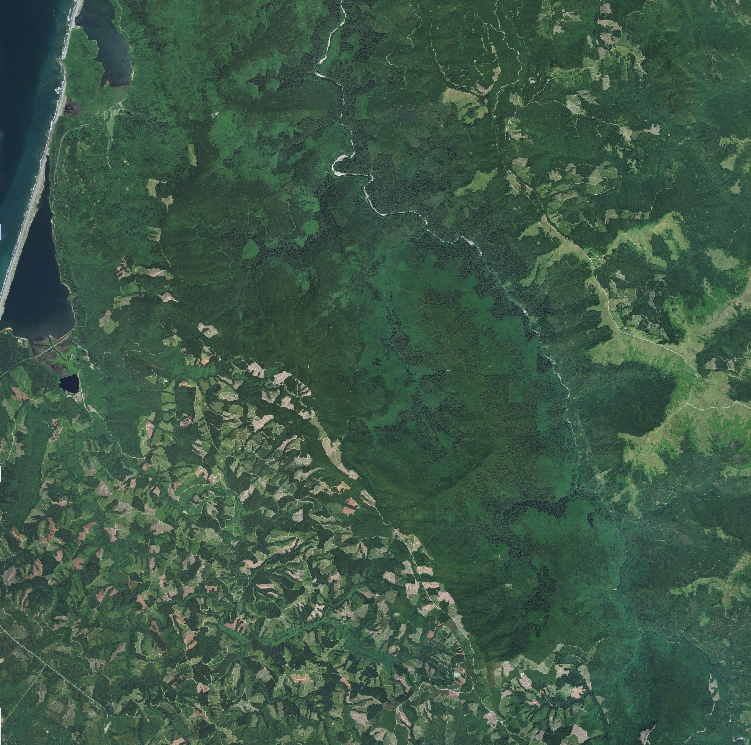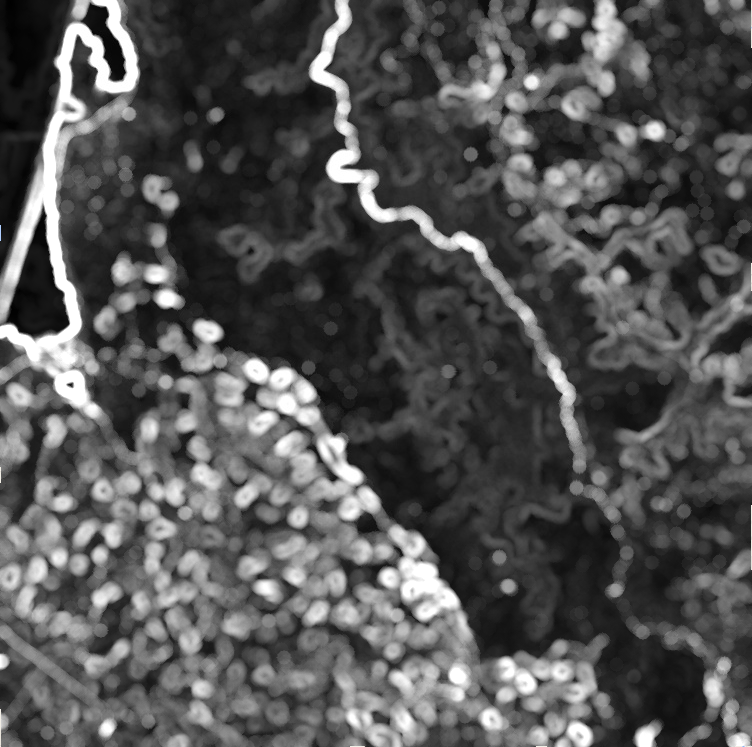您还可以指定要应用 reducer 的邻域,而不是指定要执行求和的区域。如需减少图片邻域,请使用 image.reduceNeighborhood()。在这种情况下,缩减将在输入图片上的滑动窗口中进行,窗口大小和形状由 ee.Kernel 指定。reduceNeighborhood() 的输出将是另一张图片,其中每个像素值代表输入图片中相应像素周围邻域的求和输出。图 1 展示了此类缩减。

reduceNeighborhood() 示意图,其中 reducer 应用于内核。例如,考虑使用美国国家农业影像计划 (NAIP) 影像来量化加利福尼亚红杉森林遭到砍伐所造成的景观差异。
具体而言,使用邻域中的标准差 (SD) 来表示已记录区域(图 2 中图片的西南角)与受保护区域(图 2 中图片的东北角)之间的纹理差异。例如,如需获取 NAIP 常态化差值植生指数 (NDVI) 图像的纹理,请使用 reduceNeighborhood() 计算由核定义的邻域中的标准差:
Code Editor (JavaScript)
// Define a region in the redwood forest. var redwoods = ee.Geometry.Rectangle(-124.0665, 41.0739, -123.934, 41.2029); // Load input NAIP imagery and build a mosaic. var naipCollection = ee.ImageCollection('USDA/NAIP/DOQQ') .filterBounds(redwoods) .filterDate('2012-01-01', '2012-12-31'); var naip = naipCollection.mosaic(); // Compute NDVI from the NAIP imagery. var naipNDVI = naip.normalizedDifference(['N', 'R']); // Compute standard deviation (SD) as texture of the NDVI. var texture = naipNDVI.reduceNeighborhood({ reducer: ee.Reducer.stdDev(), kernel: ee.Kernel.circle(7), }); // Display the results. Map.centerObject(redwoods, 12); Map.addLayer(naip, {}, 'NAIP input imagery'); Map.addLayer(naipNDVI, {min: -1, max: 1, palette: ['FF0000', '00FF00']}, 'NDVI'); Map.addLayer(texture, {min: 0, max: 0.3}, 'SD of NDVI');
import ee import geemap.core as geemap
Colab (Python)
# Define a region in the redwood forest. redwoods = ee.Geometry.Rectangle(-124.0665, 41.0739, -123.934, 41.2029) # Load input NAIP imagery and build a mosaic. naip_collection = ( ee.ImageCollection('USDA/NAIP/DOQQ') .filterBounds(redwoods) .filterDate('2012-01-01', '2012-12-31') ) naip = naip_collection.mosaic() # Compute NDVI from the NAIP imagery. naip_ndvi = naip.normalizedDifference(['N', 'R']) # Compute standard deviation (SD) as texture of the NDVI. texture = naip_ndvi.reduceNeighborhood( reducer=ee.Reducer.stdDev(), kernel=ee.Kernel.circle(7) ) # Display the results. m = geemap.Map() m.center_object(redwoods, 12) m.add_layer(naip, {}, 'NAIP input imagery') m.add_layer( naip_ndvi, {'min': -1, 'max': 1, 'palette': ['FF0000', '00FF00']}, 'NDVI' ) m.add_layer(texture, {'min': 0, 'max': 0.3}, 'SD of NDVI') m
计算中会包含核值不为零的任何像素。默认情况下,系统会使用核权重,但您可以使用 inputWeight 参数更改此行为。图 2 比较了输入图片和 reduceNeighborhood() 输出。


reduceNeighborhood() 输出。